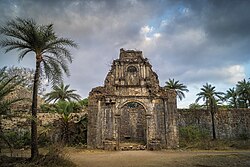Vasai-Virar
| Vasai-Virar | ||
|---|---|---|
|
|
||
| State : |
|
|
| State : | Maharashtra | |
| District : | Thane | |
| Location : | 19 ° 25 ′ N , 72 ° 50 ′ E | |
| Height : | 4 m | |
| Residents : | 1,221,233 (2011) | |
| Website : | Vasai-Virar | |
| Portal of Fort Bassein | ||
Vasai-Virar ( Marathi : वसई-विरार Vasaī-Virār ) is a city ( municipal corporation ) in the Indian state of Maharashtra with approx. 1.3 million inhabitants. It was created in 2009 through the merger of the cities of Vasai , Virar , Navghar-Manikpur and Nalasopara as well as 53 villages. Vasai-Virar belongs to the catchment area of the metropolis Mumbai (Bombay).
location
Vasai-Virar is about 50 km north of Mumbai on the coast of the Arabian Sea . The urban area stretches between Vasai Creek , an estuary of the Ulhas River in the south, and the mouth of the Vaitarna River in the north. The historic center of Vasai is located in the south on Vasai Creek, Virar is 16 km further north near the mouth of the Vaitarna. There are newly built residential areas between the two locations. Vasai-Virar is part of the Mumbai metropolitan area .
population
The city population is made up of approx. 77% Hindus , 9% Muslims , 8% Christians and approx. 2% Buddhists and Jains each ; the rest is made up of religious splinter groups such as Sikhs , Parsees and others. As is customary in northern India, the proportion of men is more than 10% higher than the proportion of women.
economy
The region was shaped by fishing and agriculture for centuries, but since the 1980s numerous small and medium-sized industrial companies have settled here.
history
Vasai, formerly known as Bassein , is a former Portuguese colony. In 1534 the Portuguese concluded the Treaty of Bassein with the Sultanate of Gujarat , in which the Sultan ceded the area of Bassein and Bombay to them. Two years later, the Portuguese built Fort Bassein. The place remained under Portuguese rule for two centuries and developed into an important base and flourishing port. In 1739, however, Bassein was attacked by the Marathas and had to surrender after a two-month siege. In the First Marathas War, the British conquered the city in 1780, but ceded it again to the Marathas two years later. In 1802, the second Bassein Treaty between the British and the Marathas was signed in Bassein . As a result of the Third Maraths War , Bassein finally became British in 1818 and was added to the Thane District of the Bombay Presidency . With the rise of Bombay, Bassein lost its importance and fell back to an insignificant coastal town.
After Indian independence in 1947, Vasai and Virar came to the state of Maharashtra in 1960. Due to the expansion of the metropolis of Mumbai, the area of Vasai and Virar experienced strong population growth from the late 20th century. On July 3, 2009, the city of Vasai-Virar ( Vasai-Virar Municipal Corporation ) was formed by merging the four cities of Vasai, Virar, Navghar-Manikpur and Nalasopara, including 53 villages. After protests by the villagers, 29 villages were again detached from the Vasai-Virar association in 2011.
Attractions
The ruins of the old Portuguese fort of Bassain and the beaches are the main attractions of the fast growing industrial city.
sons and daughters of the town
- Ivan Pereira (* 1964), Bishop of Jammu-Srinagar


